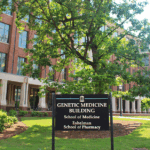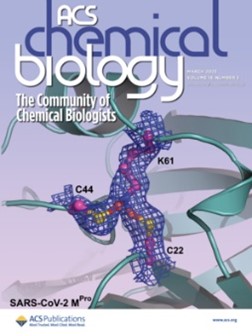News
PROTAC Linkerology Leads to an Optimized Bivalent Chemical Degrader of Polycomb Repressive Complex 2 (PRC2) Components
Frances M. Bashore, Caroline A. Foley, Han Wee Ong, Justin M. Rectenwald, Ronan P. Hanley, Jacqueline L. Norris-Drouin, Stephanie H. Cholensky, Christine A. Mills, Kenneth H. Pearce, Laura E. Herring, Dmitri Kireev, Stephen V. Frye, and Lindsey I. James*
Cite this: ACS Chem. Biol. 2023, 18, 3, 494–507; Publication Date:March 6, 2023; https://doi.org/10.1021/acschembio.2c00804
Copyright © 2023 American Chemical Society
Bivalent chemical degraders, otherwise known as proteolysis-targeting chimeras (PROTACs), have proven to be an efficient strategy for targeting overexpressed or mutated proteins in cancer. PROTACs provide an alternative approach to small-molecule inhibitors, which are restricted by occupancy-driven pharmacology, often resulting in acquired inhibitor resistance via compensatory increases in protein expression. Despite the advantages of bivalent chemical degraders, they often have suboptimal physicochemical properties and optimization for efficient degradation remains highly unpredictable. Herein, we report the development of a potent EED-targeted PRC2 degrader, UNC7700. UNC7700 contains a unique cis-cyclobutane linker and potently degrades PRC2 components EED (DC50 = 111 nM; Dmax = 84%), EZH2WT/EZH2Y641N (DC50 = 275 nM; Dmax = 86%), and to a lesser extent SUZ12 (Dmax = 44%) after 24 h in a diffuse large B-cell lymphoma DB cell line. Characterization of UNC7700 and related compounds for ternary complex formation and cellular permeability to provide a rationale for the observed improvement in degradation efficiency remained challenging. Importantly, UNC7700 dramatically reduces H3K27me3 levels and is anti-proliferative in DB cells (EC50 = 0.79 ± 0.53 μM).
March 2023
Pattenden and Hathaway Labs Move
To enable much needed additional lab space for the CICBDD, Nate Hathaway and Samantha Pattenden will grow their laboratories by moving out of Marsico Hall into the Genetic Medicine Building where they will each have larger spaces of their own.
The Pattenden lab will occupy ~1,000 square feet of space on the second floor of GMB. This more than triples the Pattenden Lab space. The main lab area will be in 2070A and half of 2070B, while an equipment room and tissue culture suite will be in 2069. Dr. Pattenden’s office is located in 2079. Student and employee write-up areas can be found in room 2078 and 2071A. Other amenities include two chemical fume hoods, a walk-in cold room and a common equipment area that are shared with the Hathaway lab. Members of the Pattenden lab are frequent collaborators with the CRISPR Screening Facility, so they are excited to be just a few lab bays away – no more taking equipment across the road on a cart!
 Nate Hathaway, the Director of the UNC CRISPR Screening Facility said that it is a bay and a half and has room for 4 researchers. His new lab space and the CRISPR center will occupy ~1,200 square feet of space on the second floor of GMB next to the Pattenden lab. The lab area has a tissue culture suite, a microscope room, a cold room and write up rooms. Dr. Hathaway’s office is located in 2077. Dr. Hathaway joined CICBDD in 2013. His lab moved into Marsico in 2014 when it was built. He added lab space in Genetic Medicine in 2018, giving him what he fondly referred to as the “North and South labs”. In 2021 the UNC CRISPR Screening Facility was opened. This additional space in GMB finally allows the Hathaway lab to all be in one location.
Nate Hathaway, the Director of the UNC CRISPR Screening Facility said that it is a bay and a half and has room for 4 researchers. His new lab space and the CRISPR center will occupy ~1,200 square feet of space on the second floor of GMB next to the Pattenden lab. The lab area has a tissue culture suite, a microscope room, a cold room and write up rooms. Dr. Hathaway’s office is located in 2077. Dr. Hathaway joined CICBDD in 2013. His lab moved into Marsico in 2014 when it was built. He added lab space in Genetic Medicine in 2018, giving him what he fondly referred to as the “North and South labs”. In 2021 the UNC CRISPR Screening Facility was opened. This additional space in GMB finally allows the Hathaway lab to all be in one location.
March 2023
Konstantin Popov Joins CICBDD
 Please join me in welcoming Dr. Konstantin Popov as a new faculty member, Research Associate Professor in the Division of Chemical Biology and Medicinal Chemistry, and Director of Computational Biophysics, here in the Center.
Please join me in welcoming Dr. Konstantin Popov as a new faculty member, Research Associate Professor in the Division of Chemical Biology and Medicinal Chemistry, and Director of Computational Biophysics, here in the Center.
Konstantin comes to us from a Research Assistant Professor position in the Department of Biochemistry and Biophysics at UNC. His research expertise is at the interface of computational and structure-guided chemical probe and drug discovery, which is a vital part of the mission of the CICBDD.
Konstantin received his PhD in polymer physics and chemistry from Moscow State University, Russia in 2009. While getting his PhD, he worked part time as a research associate at the Schlumberger Moscow Research Center. He subsequently received a year of postdoctoral training in nano drug delivery research at Northwestern University under the mentorship of Professor Monica Olvera de la Cruz. Following four additional years of postdoctoral research applying computational methods to cell motility at the University of Maryland at College Park, under the supervision of Professor Garegin Papoian, Dr. Popov was appointed as Research Assistant Professor at the Department of Biochemistry and Biophysics at UNC in 2014. At UNC he has established numerous collaborations including ones with Professors Alexander Tropsha and Andrew Lee within the Eshelman School of Pharmacy, as well as numerous other faculty in the Center and across campus. With these latter collaborations, he has been heavily involved in several recent grant applications and awards toward new anti-viral therapeutics. He will also be an important contributor to several ongoing programs toward Alzheimer’s and cancer chemical probes and therapeutics.
We are looking forward to having Konstantin be a central researcher, collaborator, and leader here in the Center. Feel free to stop by and introduce yourself.
KENNETH H. PEARCE, PhD
Research Professor, Division of Chemical Biology and Medicinal Chemistry
Director, Center for Integrative Chemical Biology and Drug Discovery
Director, Lead Discovery and Characterization
January, 2023
SLAS Discov. 2022 Dec;27(8):428-439. doi: 10.1016/j.slasd.2022.10.003. Epub 2022 Oct 19.
Discovery of hit compounds for methyl-lysine reader proteins from a target class DNA-encoded library
Devan J Shell 1 , Justin M Rectenwald 2 , Peter H Buttery 1 , Rebecca L Johnson 1 , Caroline A Foley 1 , Shiva K R Guduru 1 , Mélanie Uguen 1 , Juanita Sanchez Rubiano 1 , Xindi Zhang 1 , Fengling Li 3 , Jacqueline L Norris-Drouin 1 , Matthew Axtman 1 , P Brian Hardy 1 , Masoud Vedadi 3 , Stephen V Frye 1 , Lindsey I James 1 , Kenneth H Pearce 4
Affiliations
- PMID: 36272689
- DOI: 10.1016/j.slasd.2022.10.003
Free article
Abstract
Methyl-lysine (Kme) reader domains are prevalent in chromatin regulatory proteins which bind post-translational modification sites to recruit repressive and activating factors; therefore, these proteins play crucial roles in cellular signaling and epigenetic regulation. Proteins that contain Kme domains are implicated in various diseases, including cancer, making them attractive therapeutic targets for drug and chemical probe discovery. Herein, we report on expanding the utility of a previously reported, Kme-focused DNA-encoded library (DEL), UNCDEL003, as a screening tool for hit discovery through the specific targeting of Kme reader proteins. As an efficient method for library generation, focused DELs are designed based on structural and functional features of a specific class of proteins with the intent of novel hit discovery. To broadly assess the applicability of our library, UNCDEL003 was screened against five diverse Kme reader protein domains (53BP1 TTD, KDM7B JmjC-PHD, CDYL2 CD, CBX2 CD, and LEDGF PWWP) with varying structures and functions. From these screening efforts, we identified hit compounds which contain unique chemical scaffolds distinct from previously reported ligands. The selected hit compounds were synthesized off-DNA and confirmed using primary and secondary assays and assessed for binding selectivity. Hit compounds from these efforts can serve as starting points for additional development and optimization into chemical probes to aid in further understanding the functionality of these therapeutically relevant proteins.
Keywords: Chromatin; DNA-encoded library; Hit discovery; Methyl-lysine; Reader protein; Target class.
Copyright © 2022. Published by Elsevier Inc.
December 2022


